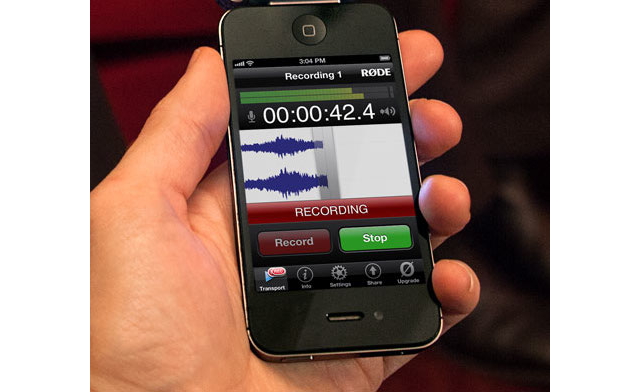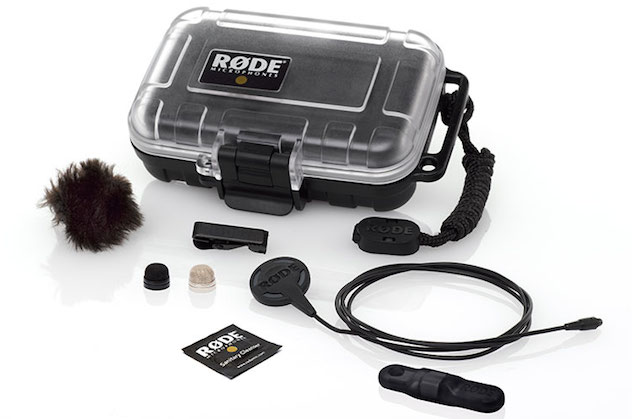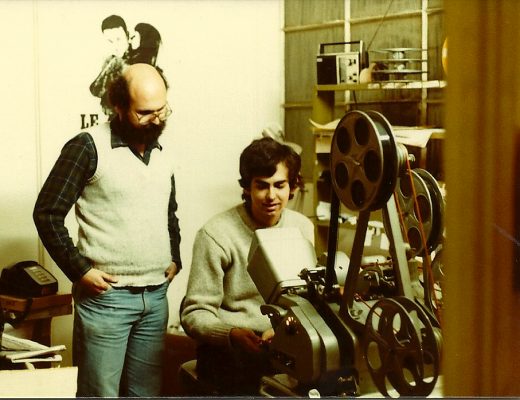
In addition to offering the wonderful RØDE REC application for iOS which I recently reviewed (link ahead), RØDE is primarily known as a renowned microphone manufacturer from Australia. One of its unique designs is the PinMic, the least obtrusive body mic I’ve ever seen, short of hiding a conventional lav inside clothing. With the PinMic, absolutely all components and cabling stay inside the clothes, except the microphone element itself, which connects to the rest via three tiny pins, which perforate the shirt or dress non-destructively.
Review of the RØDE Rec app

Here is my January 2014 RØDE Rec app review article for those who may have missed it.
The PinMic’s esthetic advantage is also practical
The “right” way to place a lav mic on a speaker
Esthetically speaking (short of hiding a conventional lav inside clothing, as has been customary with dramatic production when a boom is not desired, or for redundcancy), with a conventional, modern lavalier microphone, there is a single accepted professional way to place it on the speaker (i.e. “mic-ing” the person), and that is to have all of the cable tucked inside the clothing except a tiny piece of it that quite neatly and elegantly loops back around and is held by the mic clip. I am one of those people who absolutely cringe when I see a lavalier mic placed sloppily on a person on TV or Internet video clip, i.e. with the cable visible as it runs down or across the speaker’s clothing.
Bashful producers or sound operators
For some reason, the process of professionally “mic-ing” an interviewee or other speaker makes some producers or sound operators become bashful with regards to the process of hiding a lavalier mic’s cable in the person’s clothing. Unfortunately, that bashfulness translates into a bad impression on screen.
PinMic to the rescue
As explained earlier, the design of the PinMic is not only less visible (almost invisible) when placed on a speaker’s clothing: The design also makes it quite clear that the only way is the proper way, so that should both cure the bashfulness mentioned earlier, and create an even more discreet appearance.
The PinMic’s versatility in connectivity
Like some other microphones sold by RØDE, the PinMic terminates in a proprietary MiCon connector, which is then connected (quite securely, via screw-on threads) to one of several different types of plugs sold separately by RØDE. These currently include :
![]()
MiCon-1, for select Sennheiser devices
![]()
MiCon-2, for 3.5 mm TRS (Tip/Ring/Sleeve) devices which expect an unbalanced stereo mic level source. It places the connected mic simultaneously to the left and right channels.
![]()
MiCon-3, for select Shure devices
![]()
MiCon-4, for select Audio Technica devices
![]()
MiCon-5, for balanced 3-pin XLR devices
![]()
MiCon-6, for select AKG and Audix devices
![]()
MiCon-7, for select Lectrosonic devices
![]()
MiCon-8, for select Sony devices
![]()
MiCon-9, for select Sennheiser Lemo devices
![]()
MiCon-10, for select MIPRO devices
![]()
MiCon-11, for unbalanced TRRS (Tip/Ring/Ring/Sleeve) 4-conductor 3.5mm devices, like iPads, iPhones, iPod touches and many Android phones and tablets.
To clarify, the PinMic doesn’t include any of the MiCon mentioned terminations. You must pick what you need, and order them accordingly. Ahead you’ll see which of these terminations I used for the test recordings for this review.
What comes included with the PinMic
All of the following come with the PinMic:

The PinMic (1.5mm standard pins or Long Pin 3.5mm), theCLIP1, the MiCon Cable Management Clip, the Unpainted Mesh Head, the Anti-Trauma Case, the Tool Kit, and the so-called DeadMouse-Pin, which is a windshield.
Two audio test recordings I made
Long term readers of my reviews know that (at least whenever possible), I do audio test recordings for ProVideo Coalition magazine at 48 kHz, because 48 kHz is the absolute standard for digital audio for digital video, and I emphasize the importance of making the recording correctly from the beginning, rather than wasting time and resources to resample it later, let alone reducing the quality during the resampling process. The two following recordings are both done at 48 kHz, thanks to María Kowalski’s help with her iPad, which we used with these recordings, together with other recordings we made the same day with other professional audio devices to be reviewed in upcoming articles. As with prior reviews, you can hear the streaming MP3 directly in the SoundCloud player, or you can download the original uncompressed WAVE file from SoundCloud.
The first recording was done “directly”, i.e. without any electronics between the PinMic and the iPad, using the RØDE’s optional MICON–11 termination (illustrated earlier in this article), which goes directly to TRRS (Tip/Ring/Ring/Sleeve), which is the 4-conductor unbalanced connector found on iPads, iPhones, iPod touches and many Android devices. These devices are known for their relatively poor inboard preamp and A-to-D (analog-to-digital) converters, and that is specifically why I chose to make two separate recordings. The iPad supplied bias voltage for the PinMic. When seen superficially, bias voltage seems similar to phantom power, but is not the same. (Phantom power fans: Hold on! We’ll see that with the second test!)
The second recording was done using an external preamp and A-to-D converter (the IK Multimedia iRig Pro, which I’ll review in a separate article soon, not to be confused with the earlier iRig Pre, which I reviewed back in 2012). So for the second recording, I used the balanced mic-level signal from the PinMic with the MiCon–5 termination to feed the iRig Pro. The iRig Pro fed a digital signal to the iPad’s Lightning connector, thereby completely bypassing the iPad’s preamp and A-to-D converter. The iRig Pro also fed phantom power to the PinMic, thanks to an internal 9-volt battery inside of the iRig Pro.
Both recordings were made in mono 48 kHz WAVE with the RØDE Rec app. No equalization, compression, or filtering was applied; only normalization.
Interview with Ric Creaser, inventor of the RØDE PinMic
The above interview was supplied by RØDE.
Conclusions
The PinMic from RØDE is clearly the Ferrari of lavalier microphones, due to it esthetics and flexibility in connectivity. The current model is omnidirectional.
Related recent articles
- iOS 7 expands digital USB audio use with iPhone/iPod Touch
- RØDE Rec audio app for iOS has come a long way
- Five iOS-capable, dual-input balanced>USB audio interfaces compared
- Bossjock Studio creates a “live” radio studio in your iPad/iPhone/iPod Touch
Upcoming articles, reviews, and books
Stand by for upcoming articles, reviews, and books. Sign up to my free mailing list by clicking here.
Si deseas suscribirte a mi lista en castellano, visita aquí. Si prefieres, puedes suscribirte a ambas listas (castellano e inglés).
My latest book (paperback + ebook)
My most recent book is available in two languages, and in paperback as well as an ebook. The ebook format is Kindle, but even if you don’t have a Kindle device, you can read Kindle books on many other devices using a free Kindle app. That includes iPad, Android tablets, Mac computers, and Windows computers. Although generally speaking, Kindle books are readable on smartphones like Androids and iPhones, I don’t recommend it for this particular book since it contains both color photos and color comparison charts. The ebook is also DRM-free.
In English:

In English, it is currently available in the following Amazon stores, depending upon your region:
- Amazon.com, for the US and other countries in the Americas that don’t currently have their own Amazon store, or anywhere if you simply prefer it
- Amazon.br for Brazil
- Amazon.ca for Canada
- Amazon.de for Germany
- Amazon.es for Spain pero a lo mejor lo preferirás en castellano, a continuación)
- Amazon.fr for France
- Amazon.in for India
- Amazon.it for Italy
- Amazon.co.jp for Japan
- Amazon.com.mx for México
- Amazon.co.uk for the United Kingdom
Or in your favorite bookstore by requesting ISBN–10: 1456310232 or ISBN–13: 978–1456310233.
En castellano:

En castellano, está disponible actualmente en las siguientes tiendas Amazon, según tu región:
- Amazon.com para EE.UU. y todas las Américas donde no existe ninguna tienda particular… o en cualquier parte si simplemente lo prefieres
- Amazon.com.br para Brasil
- Amazon.co.jp para Japón
- Amazon.de para Alemania
- Amazon.es para España
- Amazon.fr (Francia)
- Amazon.in para India
- Amazon.it para Italia
- Amazon.com.mx para México
- Amazon.co.uk para el Reino Unido
o en tu librería preferida al solicitar el ISBN–10: 1492783390 ó el ISBN–13: 978–1492783398.
Allan Tépper’s other books, consulting, articles, seminars & audio programs
Contact Allan Tépper for consulting, or find a full listing of his books, articles and upcoming seminars and webinars at AllanTepper.com. Listen to his TecnoTur program, which is now available both in Castilian (aka “Spanish”) and in English, free of charge. Search for TecnoTur in iTunes or visit TecnoTur.us for more information.
FTC disclosure
No manufacturer is specifically paying Allan Tépper or TecnoTur LLC to write this article or the mentioned books. Some of the other manufacturers listed above have contracted Tépper and/or TecnoTur LLC to carry out consulting and/or translations/localizations/transcreations. Many of the manufacturers listed above have sent Allan Tépper review units. So far, none of the manufacturers listed above is/are sponsors of the TecnoTur programs, although they are welcome to do so, and some are, may be (or may have been) sponsors of ProVideo Coalition magazine. Some links to third parties listed in this article and/or on this web page may indirectly benefit TecnoTur LLC via affiliate programs.
Copyright and use of this article
The articles contained in the TecnoTur channel in ProVideo Coalition magazine are copyright Allan Tépper/TecnoTur LLC, except where otherwise attributed. Unauthorized use is prohibited without prior approval, except for short quotes which link back to this page, which are encouraged!

Filmtools
Filmmakers go-to destination for pre-production, production & post production equipment!
Shop Now













